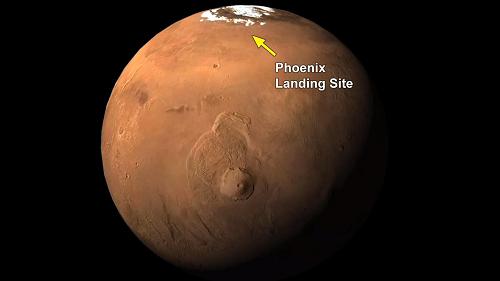NASA'S Phoenix spacecraft has discovered evidence of past water at its Martian landing site and spotted falling snow for the first time, according to scientists.
 Phoenix mission finds more evidence of past water on Mars
Phoenix mission finds more evidence of past water on Mars
 |
|
This NASA handout image obtained on September 30, 2008 shows where NASA's Phoenix Mars Mission landed at 68.2 degrees north latitude, 234.2 degrees east longitude. The far-northern location of the site is indicated on this global view from the Mars Orbiter Camera on NASA's Mars Global Surveyor. NASA's Phoenix Mars Lander has detected snow falling from Martian clouds. Spacecraft soil experiments also have provided evidence of past interaction between minerals and liquid water, processes that occur on Earth. A laser instrument designed to gather knowledge of how the atmosphere and surface interact on Mars has detected snow from clouds about 4 kilometers (2.5 miles) above the spacecraft's landing site. Data show the snow vaporizing before reaching the ground. [AFP] |
Soil experiments have revealed the presence of two minerals known to be formed in liquid water. Scientists identified the minerals as calcium carbonate, found in limestone and chalk, and sheet silicate.
But exactly how that happened remains a mystery.
"It's really kind of all up in the air," said William Boynton, a mission scientist at the University of Arizona in Tucson.
A laser aboard the Phoenix recently detected snow falling from clouds more than 2 kilometers above its home in the northern arctic plains. The snow disappeared before reaching the ground.
Phoenix landed on the Martian arctic plains in May on a three-month mission to study whether the environment could be friendly to microbial life. One of its biggest discoveries so far is confirming the presence of ice on the planet.
Scientists long suspected frozen water was buried in the northern plains based on measurements from an orbiting spacecraft. The lander also found that the soil was slightly alkaline and contained important nutrients and minerals.
Scientists think there could have been standing water at the site in the past or the ice could have melted and interacted with the minerals.
"Is this a habitable zone on Mars? I think we're approaching that hypothesis," said chief scientist Peter Smith of the University of Arizona. "We understand, though, that Mars has many surprises for us and we have not finished our investigation."
Mars today is frigid and dry with no sign of water on the surface, but researchers believe the planet once was warmer and wetter.
NASA extended the three-month mission through the end of the year if Phoenix can survive that long. With summer waning, less sunlight is reaching the spacecraft's solar panels. Phoenix will be out of touch with ground controllers briefly in November when the sun is between Earth and Mars, blocking communications.
Scientists are racing to use the remaining four of Phoenix's eight tiny test ovens before the lander dies. The ovens sniff for organic, or carbon-based compounds, that are considered the building blocks of life. Experiments have failed to turn up definitive evidence of organics.
(Shanghai Daily/Agencies October 1, 2008)